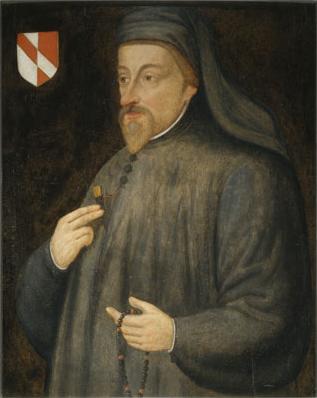Geoffrey Chaucer
Geoffrey Chaucer is perhaps best known as the writer of the Canterbury Tales, which were a series of stories based in medieval England that followed different people as they travelled to Canterbury Cathedral in pilgrimage.
Chaucer, believed by many to be one of the greatest English writers of all time, is thought to have been born between 1340 and 1345 to John Chaucer and Agnes de Copton, who lived in Thames Street near the Tower of London.
A relatively wealthy man, John Chaucer was a vinter - or wine merchant - who was most likely literate, and it is believed that he taught his son to read and write before he had even sent him to school. Historians believe Geoffrey attended St Paul’s Almonry Grammar School, which was the closest school to his home, and he would have been taught primarily in Latin as was common in medieval education.

In 1357, Geoffrey Chaucer was made to work as a page for the Duchess of Ulster, the wife of Prince Lionel - Edward III’s third son. It is believed that he stayed in this role for around 11 years, which would have taken him roughly to the time of Lionel’s death. During this time he also fought in the Hundred Year’s War, going into battle in 1359 and being taken prisoner near Rheims. He remained there for a year before he was ransomed for £16 and released. It is believed that this ransom was paid by Edward III.
In 1362 he became a squire and just four years later he married a lady in waiting to the Queen, Philippa de Roet. It wasn’t long after this when Chaucer began writing poetry, but none of it was directed towards his wife. This, along with the fact that Chaucer never wrote anything position about marriage, had led to many historians believing his marriage was arranged.
In 1369, he wrote The Book of the Duchess, which is thought to have reflected his time as a page. But his time working in more traditional posts was not over. In 1373 he was sent to Italy on royal business, potentially for trading, and this was thought to have significantly impacted on his writing. He soon returned to London and was appointed the Controller of Customs on wools, skills and hides in the Port of London, which was a position he held until 1386. Amazingly, Chaucer still found time to write and it was during this time that he produced Troilus and Criseyde, which is often labelled his first ‘true English’ novel.
In spite of his role in the port, Chaucer was now a well known write, and was soon made a Justice of the Peace and elected to Parliament as Knight of the Shire of Kent. Sadly in 1386, Chaucer’s patron John of Gaunt was sent to Spain, leaving the Duke of Gloucester to replace him. The duke chose to place his own men in the positions held by Chaucer, which meant he lost all his offices. However, his reputation as a writer meant he was now able to write full time and it was now that he began working on his most famous works of all time, the Canterbury Tales.
When John of Gaunt returned to England in 1389, Chaucer was reinstated in his old roles and was given responsibility of overseeing the king’s residences, including the Tower of London and Windsor Castle. However he was later replaced in his position as the Clerk of Works in 1391.
In his final years, Chaucer seemingly enjoyed a comfortable life, despite being widowed. He wrote many poems about his sadness towards ageing, his concern that he had lost poetic talent and his disillusionment with the world. Soon after, on 25 October 1400, he died at his home in Westminster Abbey.
See also: The Black Prince
MLA Citation/Reference
"Geoffrey Chaucer". HistoryLearning.com. 2025. Web.
Key facts
| Name: | Geoffrey Chaucer |
| Birth Date: | 1343, London |
| Death: | October 25 1400, London |
| Key role: | Medieval poet and author |
| Notable works: | The Canterbury Tales |
